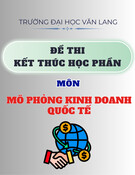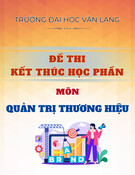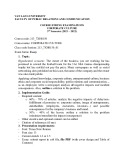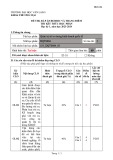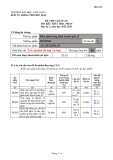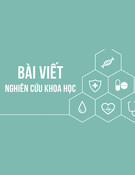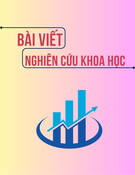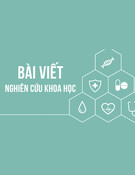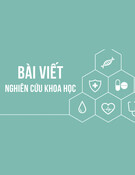
BM-003
TRƯỜNG ĐẠI HỌC VĂN LANG
KHOA THƯƠNG MẠI
ĐỀ THI VÀ ĐÁP ÁN ĐỀ THI KẾT THÚC HỌC PHẦN
Học kỳ 3, năm học 2021 - 2022
Mã học phần: 213_7TM0010_01
Tên học phần: Kinh doanh Quốc tế
Mã nhóm lớp học phần: K26DB-C01
Thời gian làm bài (phút/ngày): 75 phút
Hình thức thi: Trắc nghiệm kết hợp tự luận
Cách thức nộp bài phần tự luận: Sinh viên gõ trực tiếp trên khung trả lời của hệ thống thi.
PHẦN TRẮC NGHIỆM (7.0 điểm)
Globalization of markets results in markets becoming _____.
A. less diverse
B. more interdependent
C. more protected
D. less competitive
ANSWER: A
Early outsourcing efforts were primarily confined to _____.
A. manufacturing activities
B. service activities
C. technological research
D. health care
ANSWER: A
Which of the following is an impediment that makes it difficult for firms to achieve the
optimal dispersion of their productive activities to locations around the globe?
A. Transportation costs
B. Government deregulations
C. Reduction of barriers to trade between countries
D. Reduction of barriers to foreign direct investment
ANSWER: A
The General Agreement on Tariffs and Trade (GATT) was responsible for ____.
A. policing the global marketplace
B. protecting government owned enterprises
C. limiting nuclear testing
1

D. promoting environment friendly technology
ANSWER: A
The World Trade Organization promotes the:
A. lowering of barriers to cross-border trade and investment.
B. development of poor nations through low-interest loans.
C. state ownership of major enterprises.
D. regulation of national economies.
ANSWER: A
The G20 was originally established to:
A. formulate a coordinated policy response to financial crises in developing nations.
B. maintain order in the international monetary system.
C. preserve peace through international cooperation and collective security.
D. manage, regulate, and police the global marketplace.
ANSWER: A
The growth of international trade in services has been driven by advances in:
A. communications.
B. transportation.
C. agriculture.
D. energy.
ANSWER: A
Religion may be defined as:
A. shared beliefs and rituals that are concerned with the realm of the sacred.
B. social rules that govern people's actions toward each other.
C. routine conventions of everyday life.
D. a set of moral principles, or values, that are used to guide and shape behavior.
ANSWER: A
Which of the following statements about values and norms of a culture is true?
A. The values and norms of a society influence social structure.
B. The values and norms of a society are not the evolutionary product of a number of
factors.
C. The values and norms of a society are not influenced by religion.
D. The values and norms of a society emerge fully formed.
ANSWER: A
Mores are:
A. the norms that are seen as central to the functioning of a society and its social life.
B. the routine conventions of everyday life.

BM-003
C. abstract ideas about what a group believes to be right, good, and desirable.
D. the social rules and guidelines that prescribe appropriate behavior in particular
situations.
ANSWER: A
An act, as simple as shaking hands when meeting new people is an example of _____.
A. symbolic behavior
B. values
C. mores
D. social stratification
ANSWER: A
Even if a _____ can be characterized as having a single homogeneous culture, often that
national culture is a mosaic of subcultures.
A. society
B. culture
C. country
D. norm
ANSWER: A
Norms refer to:
A. the social rules and guidelines that prescribe appropriate behavior in particular
situations.
B. a system of values that are shared among a group of people.
C. the routine conventions of everyday life.
D. abstract ideas about what a group believes to be good, right, and desirable.
ANSWER: A
There are two main trading blocs in Europe, the European Union and the _____.
A. European Free Trade Association
B. Andean Community
C. Mercosur
D. European Council
ANSWER: A
In theory, WTO rules should ensure that a free trade agreement:
A. does not result in trade diversion.
B. does not result in trade creation.
C. results in trade creation.
D. results in trade diversion.
ANSWER: A
3

A(n) _____ entails even closer economic integration and cooperation than a common
market.
A. free trade area
B. customs union
C. economic union
D. full political union
ANSWER: A
The _____ was established to increase multinational cooperation in view of the economic
rise of the Pacific nations and the growing interdependence within the region.
A. Asia-Pacific Economic Cooperation
B. Mercosur
C. Andean Community
D. Association of Southeast Asian Nations
ANSWER: A
From least integrated to most integrated, the levels of economic integration are a:
A. free trade area, a customs union, a common market, an economic union, and a
political union.
B. common market, a free trade area, an economic union, a customs union, and a
political union.
C. customs union, a free trade area, a common market, a political union, and an
economic union.
D. common market, an economic union, a customs union, a free trade area, and a
political union.
ANSWER: A
Which level of economic integration eliminates trade barriers between member countries
and adopts a common external trade policy?
A. Customs union
B. Political union
C. Common market
D. Economic union
ANSWER: A
A(n) _____ involves the free flow of products and factors of production between member
countries, the adoption of a common external trade policy, a common currency,
harmonization of members' tax rates, and a common monetary and fiscal policy.
A. economic union
B. common market

BM-003
C. customs union
D. free trade area
ANSWER: A
Research and development, production, marketing and sales, and customer service are all
examples of _____.
A. primary activities
B. core competencies
C. value creation
D. secondary activities
ANSWER: A
Which of the following is true of firms that compete in the global marketplace?
A. Because differentiation across countries can involve significant duplication and a
lack of product standardization, it may raise costs.
B. They must employ a transnational policy in order to have a competitive edge.
C. They must employ a domestic policy in order to have a competitive edge.
D. Because differentiation across countries can involve significant duplication and a
lack of product standardization, it may reduce costs.
ANSWER: A
When a firm focuses on increasing profitability by customizing the product or service so
that they provide a good match to tastes and preferences in different national markets, the
firm is following a(n) _____ strategy.
A. localization
B. international
C. transnational
D. global standardization
ANSWER: A
_____ activities are basically concerned with creating the product, marketing and
delivering the product to buyers, and providing support and after-sales service.
A. Primary
B. Subordinate
C. Ancillary
D. Support
ANSWER: A
5

